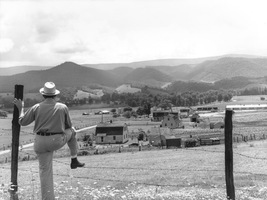 | Back to e-WV
| Back to e-WV
 The West Virginia Encyclopedia
The West Virginia Encyclopedia
 | Back to e-WV
| Back to e-WV
 The West Virginia Encyclopedia
The West Virginia Encyclopedia

The Tygart Valley Homesteads was a project of the Federal Subsistence Homesteads Corporation, created by the Roosevelt administration during the Great Depression. The idea was to provide a new start for unemployed farmers, miners, and timber workers. This was one of three resettlement projects in West Virginia, the others being at Arthurdale and Eleanor.
Initial funding in the amount of $675,000 was allocated by Congress on December 21, 1933, to acquire land in the Tygart Valley. A committee of local citizens was organized and, by 1934, land had been acquired at Dailey and Valley Bend, 10 miles south of Elkins. The plan called for the construction of 198 houses, with homesteaders to help build them. They were paid 30 cents an hour plus work credit, which could be applied to the purchase of their houses. There were 1,640 applications from families wanting to occupy the planned houses.
The first houses were ready for occupancy February 11, 1935, and by the end of 1936, 158 houses sheltered 750 people. The houses varied in size from four to six rooms, and each had from 0.9 to 2.8 acres of land. Their outbuildings included a combination garage, chicken coop, feed room, coal bin, and cellar. Ultimately, 202 houses were built or purchased and incorporated into the project.
A general supply building, a weaving center, an auto repair garage and filling station, a potato storage shed, and limestone quarry were constructed. The main industrial project was a large wood mill erected in 1937, now operated by Coastal Lumber Company. A cooperative farm, cannery, and store operated briefly. The large stone trade center building, including a bakery, restaurant, general store, barber and beauty shop, shoe repair shop, post office, and auditorium, was completed in 1937. A modern brick school building began serving the children of the homesteaders in 1939.
Eleanor Roosevelt, assisted by Congressman Jennings Randolph, promoted the homestead movement in the Tygart Valley and elsewhere. From 1934 to 1940, she made four visits to the Tygart Valley Homesteads.
The onset of World War II had an immediate impact on the settlement. Families moved elsewhere to join the war effort while men of military age left to serve the nation. By 1944, the government began to sell the homes to the settlers, and the large sawmill, trade center building, and industrial operations were soon sold to private businesses. The handsome trade center still stands as a local landmark, along with many houses and other buildings. The Tygart Valley Homesteads Historic District was listed on the National Register of Historic Places in 2004.
Read the National Register nomination.
Written by Donald L. Rice
Rice, Donald L. Randolph 200: A Bicentennial History of Randolph County, West Virginia. Elkins: Randolph County Historical Society, 1987.
Ross, Thomas R. The Tygart Valley Homesteads, Dailey and Valley Bend. Elkins: Randolph County Creative Arts Council, 1975.
Harris, Macel K. The Tygart Valley Homesteads. Davis & Elkins Historical Magazine, (Mar. 1950).